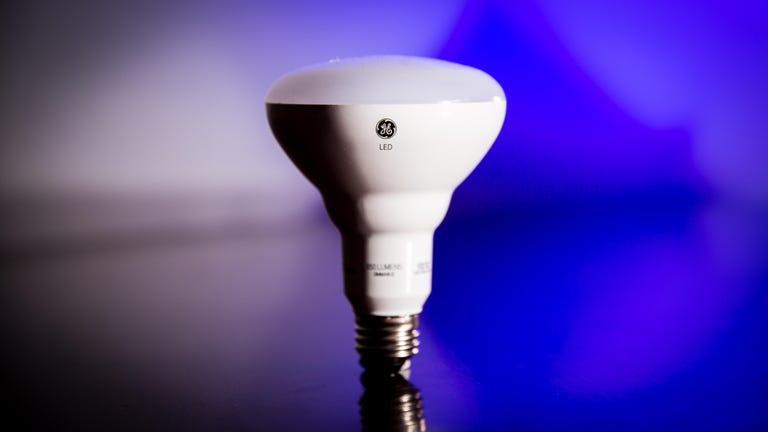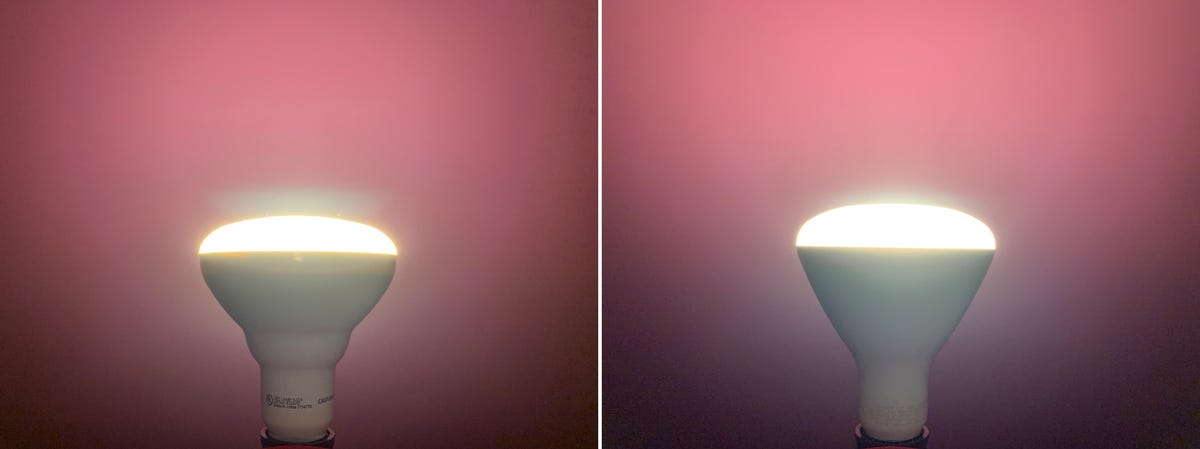 Why You Can Trust CNET
Why You Can Trust CNET GE Basic 65W Equivalent BR30 Floodlight LED review: This dimmable floodlight LED is an exceptional value
They're nothing fancy, but these dirt-cheap floodlight LEDs from GE are among the best values in the lighting aisle.
It wasn't long ago that LED floodlights would cost you $15 or even $20 per bulb. Fortunately, that's no longer the case, with a number of decent, dimmable options that won't cost you any more than $5 each. The cheapest of these: the GE Basic 65-watt Equivalent Floodlight LED, available now at Lowe's in a six-pack that costs $17. That comes out to less than $3 per bulb.
The Good
The Bad
The Bottom Line
That's obviously a terrific price, but light bulbs aren't throw-away purchases any more. Unlike their incandescent predecessors, LEDs are designed to last for years, and during that lifespan they'll have an everyday impact on the way your home looks and feels. It's not enough for a bulb to be cheap -- it has to be good, too.
Fortunately, the GE Basic LED exceeds this standard. It's as bright as you'd expect a 65-watt replacement floodlight to be, it's efficient enough to pay for itself in energy savings in less than six months, it dims well without flickering and it holds its own against heat buildup, too. That's not just good -- that's outstanding.
That said, it isn't perfect. With a projected lifespan of 6.8 years per bulb, the GE Basic LED will only last about about 30 percent as long as most of its LED competitors. On top of that, GE's two-year warranty is much shorter than the 10 years that you'll get from my top pick in the category, an excellent floodlight LED from Cree which only costs about $2 more per bulb.
Still, the GE Basic floodlight LED is a quality light bulb at an unbeatable price with relatively few compromises. It's well worth considering if you have a bunch of floodlights in your home that need replacing and you don't want the cost to get out of hand.
The GE Basic LED (left) is plenty bright, but the Cree floodlight LED (right) is a little brighter, and a little more efficient, too. The difference is slight.
Brightness and efficiency
As usual, let's start with the specs, beginning with brightness. GE claims that this bulb puts out 650 lumens, which is exactly what you want from a 65-watt replacement floodlight like this one. I measured it at 659 lumens using our lighting lab's spectrometer and integrating sphere setup.
That's a fine result, though not quite as bright as competitors like Cree or Sylvania. For something even brighter, you could also consider looking for an 85- or even a 100-watt replacement floodlight, instead.
GE gets you those 659 lumens of light from a power draw of 8.5 watts. That comes out to a very strong 77.5 lumens per watt. But again, Cree and especially Sylvania are each able to do better, topping out at over 80 and 90 lumens per watt, respectively.
Still, combine GE's efficiency with the low cost of buying in, and you're looking at the quickest payback period of any LED floodlight I've tested to date. How quick? Use a GE Basic floodlight LED to replace a 65-watt incandescent floodlight and run it for an average of 3 hours per day, and you'll knock about $7 off of your yearly energy bill. Buy them on New Year's Day, and your bulbs will each have paid for themselves by June.
Next bulb I’m testing: This GE Basic Floodlight LED, which sells in a 6-pack at @Lowes. One of your cheapest dimmable options, just $2.84 per bulb. It dims well, too, down to an average minimum of 1.7%. No visible flicker on this Lutron slider, or on a similar Leviton switch. pic.twitter.com/YG4wg1gJlT
— Ry Crist (@rycrist) January 29, 2019
Oh-so-dimmable
When I first spotted the GE Basic floodlight LEDs at Lowe's, I figured they must be nondimmable to come at such a low cost. Nope, they're dimmable all right -- and they're pretty darned good at it, too.
We test dimmability by dialing each bulb down on three different switches: two sliders from Lutron and Leviton designed for use with LEDs, and an old Lutron rotary dial intended for incandescents only. Electromagnetic interference from dimmer switches like those can cause poorly made LEDs to flicker and buzz, but that wasn't a problem with the GE Basic LED -- it dimmed perfectly well on all three of my switches, no flickering or buzzing whatsoever.
It has a good dimmable range, too, with an average minimum setting of 1.7 percent across all three switches and an average maximum of 99.8 percent. Ideally, you want your bulb to stay above 95 percent of its normal brightness at a dimmer switch's max setting, and below 5 percent at the minimum setting. So again, flying colors here for GE.
Check out the way that it dims on this old rotary dial, though. Still no flicker, still goes nice and low — but watch how quickly the brightness plummets once you get down below about 40%. Not a smooth dimming curve with older switches, it seems. A quibble, but worth knowing. pic.twitter.com/CLFg5xdEpU
— Ry Crist (@rycrist) January 29, 2019
My only complaint is a small one. On the rotary dial, the GE Basic LED had a pretty abrupt dimming curve, meaning that the brightness plummeted down to darkness after I dialed it down past 40 percent or so. That might make it tough to hit a brightness level around, say 30 percent or so.
Like I said, that's a tiny qualm, but it's one worth noting if you use outdated dimming hardware. Overall, this is still an excellent choice if you like to dim the lights, but if dimming is really that important to you, you should also consider smart bulbs, because most of them do it with perfect, flicker-free precision.
Like a lot of LEDs, the GE Basic floodlight (left) casts yellowy light that struggles with red tones, like it does with the purple wall in the picture. For something that's dramatically better at rendering accurate, vivid colors, go with a GE Reveal bulb like the one on the right.
Color quality, heat buildup and other considerations
We also test for color quality -- not the color of the light, per se, but the ability of the light to make the colors in your home look accurate and vivid.
At a measured color temperature of 2,659 K, the GE Basic LED puts out the sort of yellowy, soft white light that most shoppers look for in a light bulb. (A 5,000 K daylight version of the bulb is also available at no extra cost for folks who prefer stark white light that's closer to the blue end of the spectrum.) Like most LEDs, that light can struggle to make red tones look true, because unlike incandescent bulbs, LED bulbs don't put out very much light from the red end of the visible light spectrum.
That's not to say that the GE Basic puts out ugly light, because it doesn't. But if you've got a lot of vivid colors in your home and you're looking for bulbs that'll help them pop, you should go with something else. Your surest bet: a GE Reveal bulb -- I've tested dozens of the things over the years, and they always ace my color quality tests.
The GE Basic LED (blue) lost less of its brightness to heat buildup than almost every over floodlight we've tested.
One last wonky thing worth mentioning: heat buildup. Like most electronics, LED light bulbs generate heat when you use them, and just like your laptop or phone, performance will dip as the heat rises. That's why LEDs include things like heat sinks to keep that issue at bay. The brightness dips as the bulb heats up over the first half hour or so of use, then the heat sink kicks in to stabilize things. By the way, that "steady state" where the brightness levels off in spite of the heat is where manufacturers and independent testers like me take our final, official lumen measurements -- so don't worry, you aren't getting shortchanged on brightness.
I like to test each bulb's ability to handle the heat by calculating how much brightness it's actually shedding during that initial warm-up period. The smaller the dip, the better the chances that the bulb would perform well in an enclosed fixture, where heat gets trapped. A dip that's below 15 percent is acceptable, and a dip that's below 10 percent is excellent.
With a steady state of 92.9 percent, the GE Basic LED's dip was just 7.1 percent. That's a surprisingly strong result for such a cheap bulb -- but again, it's a close second place to Cree, which finished with a steady state of 93.7 percent and a dip of 6.3 percent.
The verdict
Dollar for dollar, the GE Basic BR30 floodlight LED is one of the best deals in the lighting aisle at less than $3 each. It only appears to be available in a six- or a 12-pack, which might be more than some shoppers need, but if you're looking to replace a whole home's worth of floodlights, the value can't be beat.
That said, GE's bulb plays runner-up to Cree's Editors' Choice-winning floodlight LED. At $5 each, it costs a little more, but it offers better brightness, better efficiency and a much better warranty. That's still the one I'd go with in my home, but the GE Basic LED is an excellent alternative that costs less.



